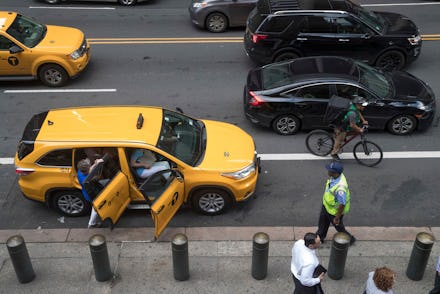Rich people are ruining cities for the rest of us

Commuting shouldn’t be a dangerous prospect, but in reality, many New Yorkers say a little prayer to themselves before running to catch their train, or hopping on their bike, or — increasingly — zooming through the city in a car.
Streetsblog reported that buried in the city’s annual Mobility Report was a factoid revealing that car registrations are up 9 percent, from 1.76 million cars in 2010 to 1.92 million in 2017. But New York City’s population only grew by 3.2 percent. What gives?
Turns out more and more of the people who can afford to live in New York and its surrounding boroughs are very, very wealthy. And as the population continues to grow, there’s less space available for them on the island of Manhattan. So they push into the outer neighborhoods, often pushing out longtime residents, who are also often immigrant families. As wealthy people live farther away from the city center, where they work, they need a car to get around reliably. Any New Yorker knows you can’t depend on the MTA, especially on the city’s fringes, for timely service.
So New York is becoming even more of a crowded hellscape, but people can be resourceful. One eco-friendly, fitness-friendly option — biking around the city — should be an incredible alternative transit option. But the lack of safe biking infrastructure and the increase in the number of vehicles on the road means cycling no longer feels safe. One example is the recent death of Devra Freelander, a 28-year-old artist living in Brooklyn. She was hit by a commercial truck barreling down a street in Bushwick, striking Freelander in the crosswalk of an intersection.
Even in cities outside of New York without reliable public transit, an influx of moneyed, metropolitan residents has contributed to congestion. “In New York, you at least have the subway and a ton of cabs to flag down and hop in at any time. In Austin, a lack of mass transit is a huge problem. Sure there’s plenty of ride-share vehicles, but that only adds to the volume of new cars on the road,” said LeeAnn Wallace, traffic reporter for Spectrum News in Austin, TX.
“As it correlates to wealth and traffic, [...] home prices have gotten so steep with the population growth, many people are either moving or relocating to surrounding cities like Round Rock, Cedar Park, or Leander but then having to undergo a longer commute into Austin for work,” Wallace said. “If you look at a map of Austin, there’s really only two highways that take you directly downtown, which is a major design flaw because those roads are consistently backed up.”
If you remember, in 2016 Lyft and Uber ceased operations in Austin, protesting Texas laws requiring all ride-share drivers to undergo fingerprinting and background checks — a problem in a region where many for-hire workers may be immigrants, but also an understandable safety precaution, with crimes committed by drivers on the rise. The strike led to the rise of a homegrown ride-sharing startup, RideAustin, which had to slash its prices once Lyft and Uber came back to the city.
I happened to be in Austin during the strike, and one late and tipsy evening, my friends and I were forced to hail a pedicab to get back to our Airbnb in a neighborhood nearby. That lucky man got a killer quad workout; my friends and I shelled out a shameful amount of cash. And I remember wishing there was a horse nearby I could commandeer and ride into the night.
All over the world, city-dwelling is becoming increasingly attractive, and necessary for work. But for regular people moving in and out of America’s downtowns, where car culture usually rules, the problem of congestion is an increasingly prevalent one.
One New Yorker just made headlines for his unconventional commute hack: a man named David Pike who lives in Jersey City but works in Brooklyn and jet skis to work everyday. His rather wet solve sounds more fun and scenic than packing into a sweaty, smelly subway car, but it’s certainly not for everyone, or all seasons. “Actually I have a wet suit, so I’m planning to go through November,” Pike told the New York Post. Hey, if you can afford a jet ski, gear, and marina parking privileges, more power to you, my dude.